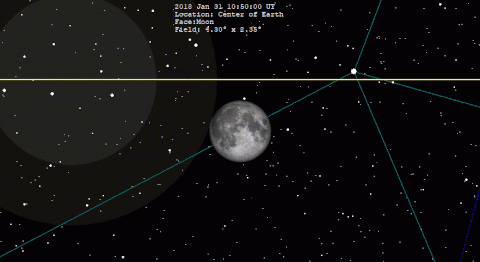31 January 2018 lunar eclipse
A total lunar eclipse will take place on January 31, 2018. The moon appears as supermoon, with perigee being on January 30. Also it is the first blue moon eclipse in 2018, so it was referred to as the super blue blood moon.[1]
Contents
[hide]
Along the U.S. West Coast, the total phase begins at 4:51 a.m. PST. The farther east you go, the closer the start of the partial phases will coincide with moonset. Along the U.S. Atlantic Seaboard, for instance, the moon will have only just begun to enter the darkest part of Earth's shadow, the umbra, at 6:48 a.m. EST when it will disappear from view below the west-northwest horizon. The duration of the total phase is 77 minutes, with the moon tracking through the southern part of the Earth's shadow. So, during totality, the moon's lower limb will appear much brighter than the dark upper limb.[4]
Related eclipses[edit]
The January 2018 lunar eclipse the first ascending node eclipse of the Lunar eclipse series sets from 2016–2020. It is also part of Saros cycle 124.
[show]Lunar eclipse series sets from 2016–2020
See also[edit]
References
Background[edit]
A lunar eclipse occurs when the Moon passes within Earth's umbra (shadow). As the eclipse begins, Earth's shadow first darkens the Moon slightly. Then, the shadow begins to "cover" part of the Moon, turning it a dark red-brown color (typically – the color can vary based on atmospheric conditions). The Moon appears to be reddish because of Rayleigh scattering (the same effect that causes sunsets to appear reddish) and the refraction of that light by Earth's atmosphere into its umbra.[2]
The following simulation shows the approximate appearance of the Moon passing through Earth's shadow. The northern portion of the Moon is closest to the center of the shadow, making it darkest, and most red in appearance.
Overview[edit]
Visibility[edit]
The Pacific Ocean will be turned toward the moon at the time of the eclipse. Central and eastern Asia (including most of Siberia), Philippines, Indonesia, New Zealand and most of Australia will get a fine view of this moon show in the evening sky. Heading farther west into western Asia, the Indian subcontinent, the Middle East and Eastern Europe, the eclipse will already be underway as the moon rises.[3]
 View of earth from moon during greatest eclipse |  Visibility map |
Timing
Event timing by timezone
| Eclipse | HST | AKST | PST | MST | CST | EST | UTC | MSK | IST | +8h | AEDT | NZDT |
|---|---|---|---|---|---|---|---|---|---|---|---|---|
| Zone from UTC | -10h | -9h | -8h | -7h | -6h | -5h | 0h | +3h | +5½h | +11h | +13h | |
| Penumbral eclipse begins | 0:51 | 1:51 | 2:51 | 3:51 | 4:51 | 5:51 | 10:51 | 13:51 | ---- | 18:51 | 21:51 | 23:51 |
| Partial eclipse begins | 1:48 | 2:48 | 3:48 | 4:48 | 5:48 | 6:48 | 11:48 | 14:48 | 17:18 | 19:48 | 22:48 | 0:48 |
| Total eclipse begins | 2:52 | 3:52 | 4:52 | 5:52 | 6:52 | ---- | 12:52 | 15:52 | 18:22 | 20:52 | 23:52 | 1:52 |
| Mid-eclipse | 3:30 | 4:30 | 5:30 | 6:30 | ---- | ---- | 13:30 | 16:30 | 19:00 | 21:30 | 0:30 | 2:30 |
| Total eclipse ends | 4:08 | 5:08 | 6:08 | 7:08 | ---- | ---- | 14:08 | 17:08 | 19:38 | 22:08 | 1:08 | 3:08 |
| Partial eclipse ends | 5:11 | 6:11 | 7:11 | ---- | ---- | ---- | 15:11 | 18:11 | 20:41 | 23:11 | 2:11 | 4:11 |
| Penumbral eclipse end | 6:08 | 7:08 | ---- | ---- | ---- | ---- | 16:08 | 19:08 | 21:38 | 0:08 | 3:08 | 5:08 |


Comments
Post a Comment